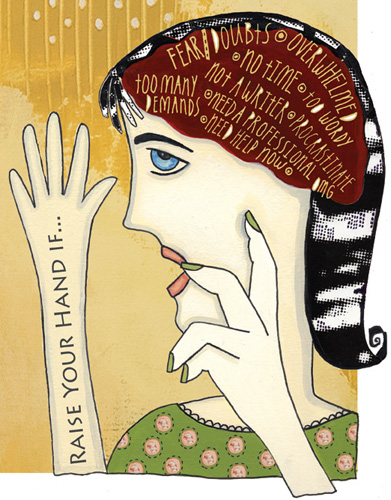By Carolyn Edlund
Is your Artist Statement prepared and ready to go? Here’s how to use it to further your art career.

Illustration by Joyce Wynes
Have you created an artist statement somewhere back in time, and not looked at it lately? Writing a concise, effective statement that encompasses your ideas, methods, practice and intention is not easy, but it is really worthwhile. Perhaps you would rather just ignore it. Or maybe you believe you really don’t need one.
Why is that statement useful, and how can it help you get noticed, gain publicity and make sales?
1. Use your artist statement in a press release, press kit, or to grab a reporter’s attention and get an interview. Featured artists on Artsy Shark frequently send their artist statement with their portfolio when submissions are open. Take a look at the Featured Artists category and scroll through. Check out all the different ways your fellow artists express themselves through their statements.
2. Want to get funding? An artist statement is frequently required when applying for that all-important grant. Even if you are seeking donations on Kickstarter or other crowdfunding site, use your artist statement as a launching pad to explain your project and pitch your cause.
3. Have you been asked to speak to a group? Perhaps as a visiting artist, presenting your work to a class or describing your art to gallery visitors? Draw from your statement to plan your talk, whether it is a full lecture or merely speaking clearly about yourself. Refer to it to stay focused on what makes you and your artwork stand out.
4. Your artist statement allows others to talk about your work. This could be a gallery owner, a curator, docent or reviewer. It could also be a gallery visitor who wants to know more about you as an artist, or to describe your work and ideas to others. Or it could be a customer, using it to share your information with others who admire your work.
5. Use your artist statement when proposing a project or show. A well-written statement and proposal helps decision makers to understand your vision, and will influence them.
6. A brochure with photos and information “about the artist” is a promotional tool you can use at retail and wholesale shows, through direct mail, or as a “leave behind” to gain publicity. A strong, well-composed artist statement helps you create effective marketing by sharing your story and ideas with prospective collectors.

The best advice of all is to get someone who can actually write to do it for you. Talk to them about what you want to say in your art, and how you say it, and then leave it to them. It’s far better to have a good writer ghost a compelling statement than go with something prosaic, lumpen, cliched or pretentious that you’ve done yourself, as is so often the case.
If you can’t write, there’s no shame in that; your job is to make arresting images.
You wouldn’t usually get an author taking their own publicity photos, so why should you write your own artist’s statement unless you can, or you have to?
Is your link bad for Rene Phillips’ article “How to Write Your Artist’s Statement with 26 Tips”? I took me to a page that said “Sorry”.
Looks like it, Ian. Thanks for the heads up. I will check with Renee to see if I can get a better link.